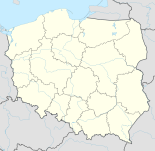Krzywe
| Krzywe | ||
|---|---|---|

|
|
|
| Basic data | ||
| State : | Poland | |
| Voivodeship : | Warmia-Masuria | |
| Powiat : | Ełk | |
| Gmina : | Prostki | |
| Geographic location : | 53 ° 45 ' N , 22 ° 36' E | |
| Residents : | ||
| Postal code : | 19-335 | |
| Telephone code : | (+48) 87 | |
| License plate : | NEL | |
| Economy and Transport | ||
| Street : | Zawady-Tworki / 1872N ↔ Cisy - Sypitki | |
| Rail route : | Small railway line (Ełk–) Laski Małe – Zawady-Tworki (no regular service) | |
| Next international airport : | Danzig | |
Krzywe [ ˈkʂɨvɛ ] ( German Krzywen , 1907-1945 Rundfließ ) is a village belonging to the municipality Prostki (Prostken) in northeastern Masuria in the Polish Warmian-Masurian Voivodeship in the powiat Ełcki ( Lyck district ).
Geographical location
The village is located 12 kilometers as the crow flies northeast of the village Prostki (German Prostken ) and 18 kilometers southeast of the district town Ełk (Lyck) .
North of Krzywe is the Jezioro Krzywe (until 1907 Krzywener See , 1907–1945 Rundfließer See ), which is connected to the larger Jezioro Stackie ( Statzener See ) via a small river .
history
In 1439 Krzywen was first mentioned in a document as a free property under Magdeburg law .
On May 27, 1874, in the course of a Prussian community reform, the administrative district Sawadden was created , to which the rural communities Brodowen , Buczylowen, Cziessen , Czyntschen , Jebramken , Klein Lasken , Krzywen, Kutzen , Ossarken, Statzen , Sypittken and the manor district Sawadden belonged. On June 30, 1906, the Sawadden District was renamed " Sypittken District ".
On July 17, 1907, the name Krzywen was renamed "Rundfließ", whereby an attempt was made to transfer the Slavic 'krzywa' (curve) on which the name was based, on which the name was based.
In 1908 the district of Sypittken includes the rural communities of Czießen, Czynczen, Klein Lasken, Kutzen, Rundfließ, Statzen and Sypittken itself as well as the district of Lyck, domain office (in part).
On December 1, 1910, Rundfließ had 444 inhabitants.
Due to the provisions of the Versailles Treaty , the population in the Allenstein voting area , to which Rundfliess belonged, voted on July 11, 1920 on whether they would continue to belong to East Prussia (and thus to Germany) or join Poland. In Rundfliess, 280 people voted to stay with East Prussia, Poland did not vote.
In 1933 there were 493 inhabitants in Rundfliess, in 1938 there were only 418.
After the end of the Second World War in 1945, the circular flow belonging to the German Reich ( East Prussia ), Lyck district , fell to Poland . The resident German population, if they had not fled, was largely expelled or resettled after 1945 and, in addition to the traditional Masurian minority, replaced by new citizens from other parts of Poland. Rundfließ was renamed in the Polish spelling of the historical place name Krzywen in "Krzywe" and is today the seat of a Schulzenamt and as such a place in the association of Gmina Prostki ( rural community Prostken ) in powiat Ełcki ( Lyck district ).
From 1975 to 1998 Krzywe belonged to what was then the Suwałki Voivodeship , then joined the newly formed Warmian-Masurian Voivodeship in 1999 .
Religions
Until 1904 Krzywen was in the Protestant Church Pissanitzen , then until 1945 in the church in Wischniewen (1938 to 1945 Kölmersdorf , Polish Wiśniowo Ełckie ) in the church province of East Prussia of the Church of the Old Prussian Union and in the Roman Catholic Church of St. Adalbert in Lyck ( Ełk) in the diocese of Warmia .
Today, on the Catholic side, Krzywe belongs to the parish in Wiśniowo Ełckie , which is part of the Ełk diocese of the Roman Catholic Church in Poland with the branch church in Sypitki . The Protestant residents stick to the parish in the district town of Ełk, a branch parish of the parish in Pisz ( Johannisburg ) in the Masuria diocese of the Evangelical Augsburg Church in Poland .
traffic
Krzywe is on a side road that connects Zawady-Tworki (Sawadden , 1938 to 1945 border guard) along the lakeside road with Sypitki (Sypittken , 1938 to 19345 four bridges) .
In October 1913, the place was connected to the Lycker Kleinbahnen with its own breakpoint , creating a direct rail link to the district town of Lyck (Ełk) .
Individual evidence
- ↑ Polish Postal Code Directory 2013, p. 628
- ↑ a b Rolf Jehke, Sawadden / Sypittken / Vierbrücken district
- ^ Uli Schubert, community directory, district of Lyck
- ↑ Herbert Marzian , Csaba Kenez : self-determination for East Germany. Documentation on the 50th anniversary of the East and West Prussian referendum on July 11, 1920. Editor: Göttinger Arbeitskreis , 1970, p. 86
- ↑ Michael Rademacher: German administrative history from the unification of the empire in 1871 to the reunification in 1990. District of Lyck (Lyk, Polish Elk). (Online material for the dissertation, Osnabrück 2006).
- ↑ Gmina Prostki ( Memento of the original from December 10, 2016 in the Internet Archive ) Info: The archive link was inserted automatically and has not yet been checked. Please check the original and archive link according to the instructions and then remove this notice.
- ↑ Walther Hubatsch : History of the Protestant Church in East Prussia. Volume 3: Documents. Göttingen 1968, p. 494

